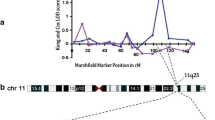Abstract
Addiction is a complex, multi-factorial disease, and thus, analyzing genetic variants at multiple loci and gene-gene interactions among them (epistasis) can provide crucial clues about causative factors of addiction which cannot be detected with single-nucleotide polymorphism (SNP) association studies. In this study, we discuss the interaction between the 1359 G/A polymorphism of the CNR1 gene and the DRD2 gene polymorphisms and the net effect of any possible epistasis on the cannabis addiction phenotype in a Turkish population. Using bivariate synergy and mutual information concepts as a means of capturing the magnitude of interaction between marker pairs, the present study not only confirms the A1 marker allele as a risk factor but also reveals a finer-grained association between A and B markers which manifests itself both as a preventive and a risk factor. Our results indicate that the increased phenotype of cases require an individual to be either heterozygous at both loci or homozygous at locus B with homozygous risk factor A1A1 present. We hypothesize that overlapping expressions of CB1 and D2R is the cause of CB1-D2R interactions in cases of substance abuse and the different polymorphisms of CNR1 and DRD2 genes may have decisive roles in the nature of these interactions in terms of promoting or alleviating the cannabis addiction risk factor of the individual.
Similar content being viewed by others
References
Albercht DS, Skosnik PD, Vollmer JM et al (2013) Striatal D2/D3 receptor availability is inversely correlated with cannabis consumption in chronic marijuana users. Drug Alcohol Depend 128:52–57
Anastassiou D (2007) Computational analysis of the synergy among multiple interacting genes. Mol Syst Biol 3:83
Blume LC, Bass CE, Childers SR et al (2013) Striatal CB1 and D2 receptors regulate expression of each other, CRIP1A and delta opioid systems. J Neurochem 124:808–820
Brenner N, Strong SP, Koberle R, Bialek W, de Ruyter van Steveninck RR (2000) Synergy in a neural code. Neural Comput 12:1531–1552
Cheverud J, Routman J (1995) Epistasis and its contribution to genetic variance components. Genetics 139:1455–1461
Chiang YC, Lo Y, Chen J (2013) Crosstalk between dopamine D2 receptors and cannabinoid CB1 receptors regulates CNR1 promoter activity via ERK1/2 signaling. J Neurochem 127:163–176
Cover T, Thomas J (2006) Elements of information theory, 2nd edn. Wiley Interscience, New York
Dong C, Chu X, Wang Y et al (2008) Exploration of gene–gene interaction effects using entropy-based methods. Eu J Hum Genet 16:229–235
Evans DM, Marchini J, Morris AP, Cardon LR (2006) Two-stage Two-locus models in genome-wide association. PLoS Genet 2:1424–1432
Franco R, Casadó V, Cortés A et al (2007) Basic concepts in G-protein-coupled receptor homo- and heterodimerization. Sci World J 7:48–57
Hallgrímsdóttir IB, Yuster DS (2008) A complete classification of epistatic two-locus models. BMC Genet 9:17
Isir AB, Nacak M, Balci SO et al (2015) Relationship between the 1359 G/A polymorphism of the Central Cannabinoid Receptor 1 (CNR1) gene and susceptibility to cannabis addiction in a Turkish population. Australian J Forensic Sci 47:230–238, http://dx.doi.org/10.1080/00450618.2014.936895
Kang G, Yue W, Zhang J et al (2008) Two-stage designs to identify the effects of SNP combinations on complex diseases. J Hum Genet 53:739–746
Khan SS, Lee FJ (2014) Delineation of domains within the cannabinoid CB1 and dopamine D2 receptors that mediate the formation of the heterodimer complex. J Mol Neurosci 53:10–21
Mackie K (2005) Distribution of cannabinoid receptors in the central and peripheral nervous system. Handb Exp Pharmacol 168:299–325
Monteleone P, Bifulco M, Di Filippo C et al (2009) Association of CNR1 and FAAH endocannabinoid gene polymorphisms with anorexia nervosa and bulimia nervosa: evidence for synergistic effects. Genes Brain Behav 8:728–732
More SV, Choi D-K (2015) Promising cannabinoid-based therapies for Parkinson’s disease: motor symptoms to neuroprotection. Mol Neurodegener 10:17
Nacak M, Isir AB, Balci SO, Pehlivan S, Benlier N, Aynacioglu S (2012) Analysis of dopamine D2 receptor (DRD2) gene polymorphisms in cannabinoid addicts. J Forensic Sci 57:1621–1624
Nutt DJ, Lingford-Hughes A, Erritzoe D, Stokes PR (2015) The dopamine theory of addiction: 40 years of highs and lows. Neuroscience 16:305–312
Phillips P (1998) The language of gene interaction. Genetics 149:1167–1171
Sherwin WB (2010) Entropy and information approaches to genetic diversity and its expression: genomic geography. Entropy 12:1765–1798
Ujike H, Takaki M, Nakata K et al (2002) CNR1, central cannabinoid receptor gene, associated with susceptibility to hebephrenic schizophrenia. Mol Psychiatry 7:515–518
Varadan V, Anastassiou D (2006) Inference of disease-related molecular logic from systems-based microarray analysis. PLoS Comput Biol 2:585–597
Wade M (2002) A gene’s eye view of epistasis, selection and speciation. J Evol Biol 15:337–346
Zammit S, Spurlock G, Williams H et al (2007) Genotype effects of CHRNA7, CNR1 and COMT in schizophrenia: interactions with tobacco and cannabis use. Br J Psychiatry 191:402–407
Zuo L, Kranzler HR, Luo X, Covault J, Gelernter J (2007) CNR1 variation modulates risk for drug and alcohol dependence. Biol Psychiatry 62:616–626
Author information
Authors and Affiliations
Corresponding author
Rights and permissions
About this article
Cite this article
Isir, A.B., Baransel, C. & Nacak, M. An Information Theoretical Study of the Epistasis Between the CNR1 1359 G/A Polymorphism and the Taq1A and Taq1B DRD2 Polymorphisms: Assessing the Susceptibility to Cannabis Addiction in a Turkish Population. J Mol Neurosci 58, 456–460 (2016). https://doi.org/10.1007/s12031-016-0721-z
Received:
Accepted:
Published:
Issue Date:
DOI: https://doi.org/10.1007/s12031-016-0721-z




